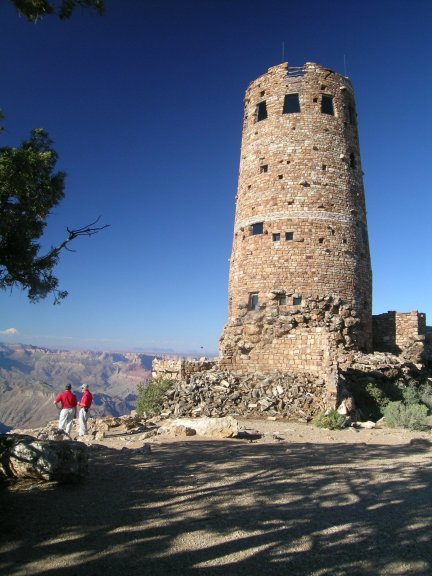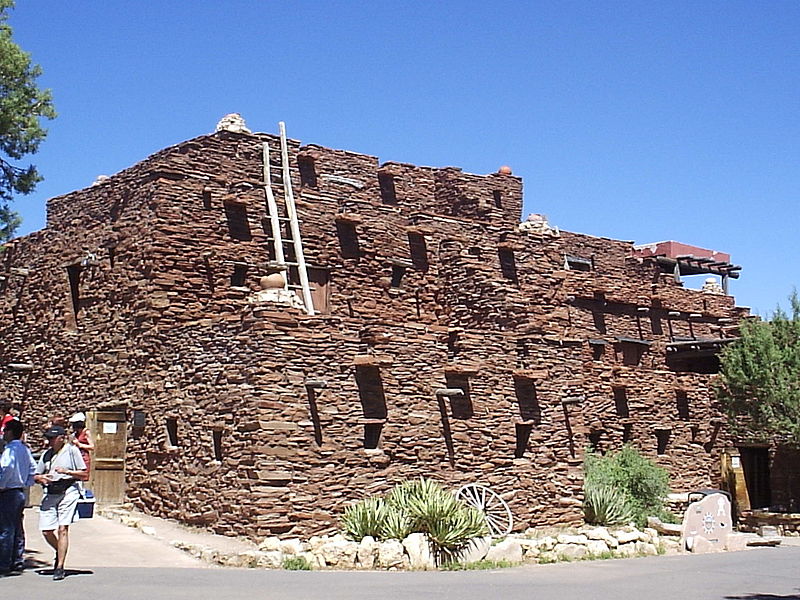American architect Mary Jane Colter is often described as a perfectionist. As one of the few female architects working in the United States between 1910 and 1950, Coulter's passion for history figured strongly into the iconic buildings she designed. While Colter had a long and successful career throughout the US Midwest, it is her work in designing many of Grand Canyon National Park's most recognizable structures that she is lauded for.
On Pure Adventures' Sedona to Grand Canyon self-guided road cycling tour, travelers follow a route that takes in many of the buildings that Colter designed in the Park. Read on to learn more about Coulter and the impression she left on the Grand Canyon.
Desert View Watchtower
![]()
Source: Ross Statham via Wikimedia
At 70 feet tall, the four-story Desert Watchtower at the Grand Canon dwarfs any of Ancient Pueblo Peoples watchtowers it was modeled after. The tower was the last building in the visitor concession series designed by Colter, with construction completed in 1932. Colter spent six months researching prototypes and construction techniques before building a model of the site and even had a 70-foot platform built to ensure spectacular views from the site. Visit the Desert Watchtower on day 4 of Pure Adventures' self-guided cycling tour of the Grand Canyon.
Hermit's Rest
![]()
Source: Notary137 via Wikimedia
"You can't imagine what it cost to make it look this old," Colter told critics of Hermit's Rest's aged-looking interior. Standing only a few feet from the rim of the Grand Canyon, partially buried in an earth mound, portions of Hermit's Rest look like a natural rock formation. The stone arch is decorated with a broken bell that Colter salvaged from a Spanish mission in New Mexico. See Hermit's Rest on day 5 of Pure Adventures' self-guided Grand Canyon cycling tour.
Phantom Ranch
![]()
Credit: Mhazhiker via Wikimedia
Originally called Roosevelt Ranch, the 1922 resort village of Phantom Ranch rests on land once used by Native Americans; pit houses and a ceremonial kiva dating from about 1050 have been found there. Colter suggested the name change because she felt it had a better "mental image" for visitors. Construction was difficult as all the building materials except rock had to be hauled down by mules. The popularity of Colter's Phantom Ranch led to National Park's staff instituting the permit system.
Hopi House
![]()
Credit: Nanosauromo via Wikipedia
Built in 1905, Hopi House was the first of eight projects in the Park designed Colter. She hoped that Hopi House would act as a living museum, in which Hopi Indians could live while making and selling traditional crafts.
Lookout Studio
![]()
Credit: Postdlf via Wikimedia
Built in 1914, Lookout Studio features Colter's trademark use of jagged native rocks which blend in with their surroundings. Resting at the edge of Grand Canyon, the three level lookout is comprised of a gift shop, viewing area and observation tower. Unique to the Lookout Studio -- in comparison to Colter's other designs -- is how brightly lit the interior is. Telescopes on its outdoor terrace allow visitors take in the Canyon's sweeping views.
On Pure Adventures' Sedona to Grand Canyon self-guided road cycling tour, travelers follow a route that takes in many of the buildings that Colter designed in the Park. Read on to learn more about Coulter and the impression she left on the Grand Canyon.
Desert View Watchtower

Source: Ross Statham via Wikimedia
At 70 feet tall, the four-story Desert Watchtower at the Grand Canon dwarfs any of Ancient Pueblo Peoples watchtowers it was modeled after. The tower was the last building in the visitor concession series designed by Colter, with construction completed in 1932. Colter spent six months researching prototypes and construction techniques before building a model of the site and even had a 70-foot platform built to ensure spectacular views from the site. Visit the Desert Watchtower on day 4 of Pure Adventures' self-guided cycling tour of the Grand Canyon.
Hermit's Rest

Source: Notary137 via Wikimedia
"You can't imagine what it cost to make it look this old," Colter told critics of Hermit's Rest's aged-looking interior. Standing only a few feet from the rim of the Grand Canyon, partially buried in an earth mound, portions of Hermit's Rest look like a natural rock formation. The stone arch is decorated with a broken bell that Colter salvaged from a Spanish mission in New Mexico. See Hermit's Rest on day 5 of Pure Adventures' self-guided Grand Canyon cycling tour.
Phantom Ranch

Credit: Mhazhiker via Wikimedia
Originally called Roosevelt Ranch, the 1922 resort village of Phantom Ranch rests on land once used by Native Americans; pit houses and a ceremonial kiva dating from about 1050 have been found there. Colter suggested the name change because she felt it had a better "mental image" for visitors. Construction was difficult as all the building materials except rock had to be hauled down by mules. The popularity of Colter's Phantom Ranch led to National Park's staff instituting the permit system.
Hopi House

Credit: Nanosauromo via Wikipedia
Built in 1905, Hopi House was the first of eight projects in the Park designed Colter. She hoped that Hopi House would act as a living museum, in which Hopi Indians could live while making and selling traditional crafts.
Lookout Studio

Credit: Postdlf via Wikimedia
Built in 1914, Lookout Studio features Colter's trademark use of jagged native rocks which blend in with their surroundings. Resting at the edge of Grand Canyon, the three level lookout is comprised of a gift shop, viewing area and observation tower. Unique to the Lookout Studio -- in comparison to Colter's other designs -- is how brightly lit the interior is. Telescopes on its outdoor terrace allow visitors take in the Canyon's sweeping views.